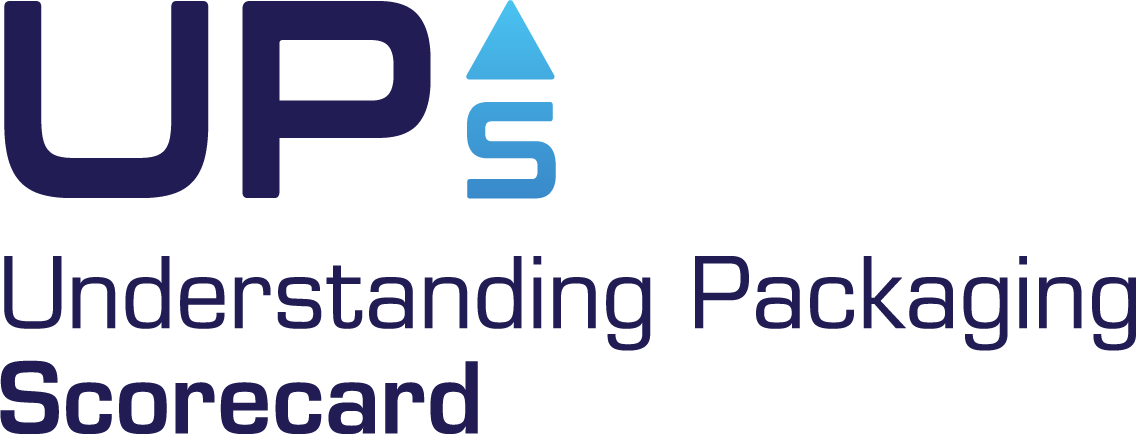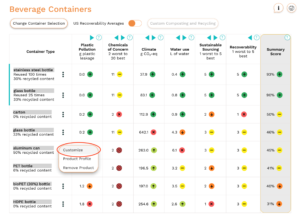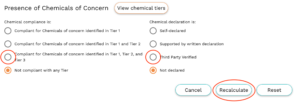Of the six metrics within the UP Scorecard, perhaps one of the most novel and talked about is the Chemicals of Concern (CoC) metric. Recently, there have been some important questions asked by users about how exactly the metric works, how a product’s CoC score can be improved, and what they can do to better address this impact area when choosing which foodware or food packaging to use. This blog article is here to help answer those questions and get you started in better incorporating this important metric into your decision-making.
Why a Chemicals of Concern metric?
The presence of toxic chemicals in foodware and food packaging associated with harm to humans and the environment is well documented. Additives and other substances that are intended to improve the performance of a material can have the unintended consequence of contaminating food or beverages as well as dispersing harmful chemicals in the environment during either production or end of life (i.e., via. composting, recycling, or incineration). A recent peer-reviewed consensus statement written by 33 international scientists and supported by 200+ environmental groups via a declaration of concern pointed out that harmful chemicals in food packaging pose a growing risk to human health and the environment because:
- Global regulations of chemicals in foodware and food packaging are inadequate;
- There are critical gaps in information needed to properly assess and address the human and environmental hazards and risks; and
- Their presence hinders efforts to achieve a circular economy.
The CoC metric within the UP Scorecard helps users be proactive and go beyond the currently inadequate regulatory requirements to address hazardous chemicals that are knowingly still being used today in foodware and food packaging. Making this extra effort helps to both better protect consumer and environmental health while also proactively avoiding problematic materials that could create legal problems for companies in the future.
How does the CoC metric work?
Developed by a cross-sector group of scientists and technical experts, the CoC metric provides a starting point and pathway for choosing safer foodware and food packaging. The metric scores each foodware and food packaging product in two ways and is based on a matrix approach. First, two separate scores are calculated for each product:
- Presence Score: Rewards products for claiming to not use substances on the Food Chemicals of Concern (FCOC) List and for the level of verification that can be provided for this claim. A maximum of 10 points can be achieved for this score.
- Inertness Score: Rewards products for using food contact materials with a high level of inertness, which serves as a proxy for the propensity of any present chemicals to migrate from the material into food and the environment. A higher inertness score indicates a lower likelihood of chemicals to migrate out of the product. A maximum of ten points can be achieved for this score.
These two sub-scores are then added together to calculate a Total CoC Score, which is presented on the UP Scorecard’s overall results page. A total of 20 points can be achieved for the CoC score.
How can a product’s CoC score be improved?
Every foodware and food packaging product available on the market can be produced differently using various chemicals along the supply chain. Because of this, all products are assumed to contain harmful chemicals known to be used in foodware and food packaging and are therefore assigned with the lowest Presence Score by default. This is where users can play a role. The Presence Score can be improved by confirming that a product is free of chemicals on the FCOC List. To do this, first open the “Customize” menu on the results page for a product as shown in Figure 1 below.
Figure 1. The Presence Score for each product can be improved by visiting the “Customize” page for a product. This is accessed via the ‘three dots’ menu to the right of a product’s name in the results table.
Once open, there is a special section at the bottom of the customization page labeled “Presence of Chemicals of Concern” (as shown in Figure 2 below). Here, select on the left side of the screen which of the three chemical tiers within the FCOC List the product is free of. Note that in order to be compliant with a tier, the product must not contain any of the chemicals included within that tier. Then, select on the right side of the screen how this declaration has been made. This declaration can either simply be self-declared by the manufacturer/supplier (such as informally via phone call), supported with a written declaration (public web statement or a declaration signed by an officer of the company), or verified using a recognized third-party (such as an external auditor or testing laboratory). The most additional points can be earned for declarations that are third-party verified.
Figure 2. Claiming compliance with any of the three tiers in the FCOC List will increase its CoC score. Users must also verify exactly how this declaration has been made.
For example, when declaring that an aluminum beverage can is compliant with all three tiers in the FCOC List and that this declaration is third-party verified, then the total CoC score increases on the results page from 2 to 11 (out of 20).
Unlike the Presence Score, the Inertness Score within the CoC metric is fixed and assigned to a product based on the material layer in contact with the food. This score helps to consider the potential for an overall migration of hazardous chemicals into food, including those added intentionally as well as those that may be unintentionally present (such as impurities and reaction byproducts). Some scientific studies exist that measure what is known as the ‘overall migration’ of all chemicals in a material into food, but there is simply not enough data available to accurately compare different materials using this value. To address this, the Inertness Score is based on expert judgment. Ceramics, glass, and stainless steel have been assumed to have low potential for overall chemical migration, and thus high inertness, receiving a score of 10. On the opposite end of the spectrum, the consulted experts agreed that recycled paper and board have a high potential for overall chemical migration, and thus low inertness. Products made from recycled paper and board, therefore, receive a low score of 1.
For all other material types, no consensus could be reached by the experts on their inertness. Without this consensus and without reliable scientific data to define the overall migration potential of the other materials, a precautionary approach is taken that assumes the worst case and assigns an Inertness Score of 1 for these other materials. As this is an uncertain assumption, all CoC results presented for products with these materials are clearly marked as being uncertain using a hashed circle in the CoC column on the Scorecard’s results page. Future versions of the UP Scorecard aim to improve this approach following additional expert input and data provided by product manufacturers and/or structured testing campaigns.
For more details and discussion on the calculations and data within the CoC metric, see the full UP Scorecard methodology document.
How to find out which chemicals are in a product?
To improve a product’s CoC score, you first have to know if it contains any of the hazardous chemicals in the FCOC List. Unfortunately, for downstream users and purchasers, a lack of information flow across the supply chain can make this sometimes difficult to figure out. Packaging manufacturers are not currently required by law to label their products with their manufacturing ingredients (unlike food products). A good first step is to talk with your packaging supplier and request information about the ingredients and chemicals used to make the product. This might include base materials (such as plastic resins) as well as any used additives (such as colorants, UV filters, printing inks, or anti-oxidizing agents). Also important is to not forget about any coatings that might be applied to the material that comes in contact with the food (such as plastic linings in beverage cans or water/grease resistant coatings on paper products). Some testing laboratories are also able to detect the presence of certain chemicals within the FCOC List, but a much more effective (and low cost) way to ensure these chemicals are not present is to collect the information directly from the upstream suppliers.
In case you just cannot find the data to improve the CoC score of a product (especially for less-inert materials such as plastics or paper), a simple option is to consider instead using a more inert material (such as steel, glass, or ceramic) that by default can achieve a better CoC score. Be sure to also check out the reusable versions of products made from these inert materials – they often score very well across all impact areas.
Regardless of how your search for chemical data goes, don’t get discouraged. Chemicals are an important but still complex and often overlooked impact area. The CoC metric helps provide a starting point for discussions between food service organizations and their suppliers about how to source safer foodware and packaging. Even just beginning and maintaining these discussions within your organization sets you on the right path. Be sure to also share your experiences and exchange learnings with your peers across the industry. This is an area where we will all have to work together to get safer materials more widely available on the market.
What’s next for the CoC metric?
The CoC metric in the UP Scorecard is a first in the industry. While the CoC metric can continue to evolve and be refined, it is an important step forward in helping procurement professionals, many for the very first time, begin to consider the presence of hazardous chemicals in foodware and packaging in their decision-making.
Ultimately, avoidance of CoCs, while an important starting point, can still lead to using other, potentially even more harmful, substances if these alternatives are not properly designed and tested. This is known as ‘regrettable substitution’.
Future versions of the UP Scorecard aim to incorporate full chemical hazard assessment and optimization options to help companies move beyond the avoidance of chemicals of concern and declarations of “free of” and instead encourage suppliers to offer verified safe and circular options. This is a systemic change that will require better tracking of information as well as innovation across the supply chain. Tools such as ChemFORWARD and GreenScreen can help to identify, evaluate, and verify safer chemicals and products using full chemical hazard assessments. The six classes framework can also be used to help avoid regrettable substitutions by phasing out entire classes of chemicals of concern (e.g., not replacing BPA with another bisphenol or replacing dibutyl phthalate with another phthalate). Proactive and progressive companies leading the effort will reap the rewards by staying ahead of regulations and building a growing community of informed buyers and consumers.
Do you have any constructive and evidence-based feedback on how we can further improve the CoC metric? Any recommendations on data sources that could help? Or maybe you had success improving the CoC score of a product or working with your supply chain to start addressing chemicals of concern? If so, we would love to hear about it! Fill out our feedback form or get in touch with us via email.
Special thanks to the other members of the CoC metric working group within the UP Scorecard for their support in developing this article: Anna Soehl (Green Science Policy Institute), Boma Brown-West and Cassie Huang (EDF), Jane Muncke (Food Packaging Forum), and Stacy Glass (ChemFORWARD).






